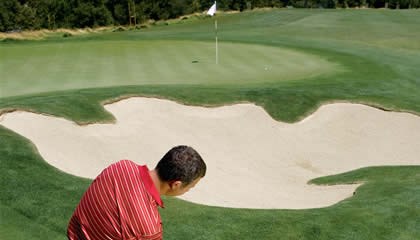Short Game Tips To Save Par
Last updated:
If the best players in the world hit only 12 or 13 greens a round in regulation, how many are you hitting? The reality of golf is that you’re going to miss a lot of greens. But when you do, there’s still a chance to save par if you have a good plan and the confidence to execute it. When I do playing lessons, I’ve noticed there are six short-game situations that give amateurs the most trouble. Whether it’s anxiety or a lack of know-how, amateurs tend to turn pars into double bogeys when they face these shots. With some practice, you can reverse that trend.
1. Chipping From The Short Side

When the ball is close to the hole and sitting down in the rough, it’s too risky to try to chip it out—there’s no room for error—and putting is out of the question. Instead, play a miniature bunker shot so the ball comes out high and lands soft, trickling only a few feet before stopping. One caveat: You have to have the guts to make a half swing from just a few yards off the green.
How To
 |
To hit this little shot, open the face of your sand wedge (left), as you would on a greenside bunker shot, and lower the shaft closer to the ground. When you swing, the goal is to keep the face open and allow the trailing edge of the club to slide through the grass on a shallow angle starting behind the ball. Acceleration is the key. |

2. Pitching High Over Trouble
 |
Ask amateurs to hit a pitch shot onto a green, and they usually can do it. Then put them behind a bunker, water hazard or any obstacle requiring a carry, and they suddenly try to scoop the ball into the air. That leads to a thin or fat shot that usually ends up in the hazard or over the green. You don’t have to be intimidated by this shot. Just set up correctly and let the sand wedge—which is designed to be forgiving when you don’t make great contact—do its job. |
How To
 |
To hit this little shot, open the face of your sand wedge (left), as you would on a greenside bunker shot, and lower the shaft closer to the ground. When you swing, the goal is to keep the face open and allow the trailing edge of the club to slide through the grass on a shallow angle starting behind the ball. Acceleration is the key. |

3. Dealing With An Elevated Green
 |
When you have a short shot to an elevated green, your No. 1 goal should be distance control. If you don’t hit the ball far enough, it might end up rolling back down the hill, stopping at your feet. And because you can’t see the cup, it’s much harder to rely on feel to get the ball to fly the correct distance. In this situation, you need to play the percentages and go with the least risky shot. The bump-and-run is the play, because pitching the ball to the hole requires a much more precise swing. |
How To
 |
First, club selection: Take a less-lofted club, nothing higher than a 7-iron. Set up with your weight and clubshaft leaning toward the target, and maintain that hands-ahead position through impact (left). The quicker you can get the ball on the ground, the better. The ball should bounce a few times before rolling onto the green. |
 Short Game Tips To Save Par – Page 2
Short Game Tips To Save Par – Page 2
© GOLF DIGEST
4. Lagging A Long Putt
You might not make a lot of 40-footers, but you can give yourself a chance by getting the ball to the hole. The tendency on a long putt with the standard shoulder-driven, quiet-hands stroke is to come up short because it lacks power. But if you use some wrist action, you generate enough energy without a big stroke, which could cause poor contact.
How To

Focus on keeping the butt end of your putter pointing at the same spot on your abdomen, as you would if you had it anchored like a belly putter (left). You’ll have to hinge and release your wrists, back and through, to keep the shaft pointing at that spot. Try it, and notice how much more power you can produce with a little flick (release) of the wrists.

5. Escaping A Downhill Bunker Lie
 |
One of the hardest shots in golf for any player is the downhill lie in greenside sand. The most important thing to remember is that it’s nearly impossible to hit a high-lofted shot from this lie, so don’t even try. At best, the ball will come out low and roll. Even if the hole is cut close, your goal should be getting the ball on the green.
|
How To
 |
Get the feel of the proper setup by lifting your arms out to your sides and matching them to the angle of the slope (left). That’s the tilt your body should take at address. Now play the ball back in your stance, and swing down the slope, skimming the sand as if it were a flat shot. Finish low. If it helps, step down the slope as you swing through. |

6. Executing The Half Wedge
When you’re close enough to the green that you can no longer make a full swing, focus on body turn and acceleration. Most amateurs try to hit half-wedge shots using only their arms. Even worse, they slow down the club because they swing out of fear of hitting the shot too far. To control distance, let your body power the motion and accelerate the club.
How To
 |
On the practice tee, address a half-wedge shot with your right foot back and up on its toes (left). This forces you to make a body swing, pivoting around your left leg. It also helps position the bottom of your swing past the ball, ensuring crisp contact. The faster you pivot your body around your left leg, the higher and farther the ball will go. |
 Short Game Tips To Save Par – Page 1
Short Game Tips To Save Par – Page 1
© GOLF DIGEST


